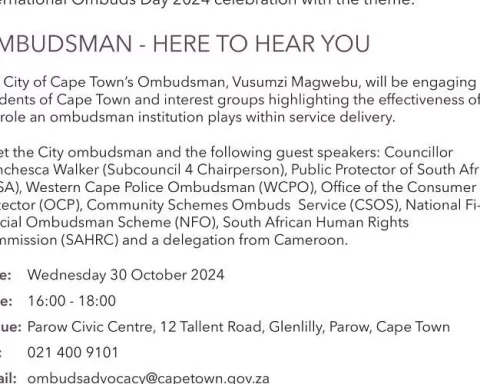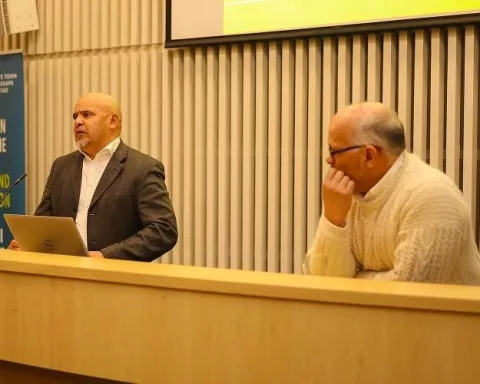Ms. Barbara Creecy envisions a reliable transport system that promotes economic prosperity and enhances connectivity in the country despite challenges such as deteriorating road conditions, logistics hurdles, capacity constraints, and poor road safety. She plans to implement meaningful reforms at Transnet, prioritize road safety measures, and upskill the existing workforce while embracing new technologies. Her vision for the future of South Africa’s transport sector is optimistic and proactive, promising a brighter tomorrow.
What is the future of South Africa’s transportation sector?
In her inaugural address as Transport Minister, Ms. Barbara Creecy outlined her vision for a reliable transport system that can promote economic prosperity while enhancing the country’s connectivity. Despite existing challenges such as logistics hurdles, deteriorating road conditions, capacity constraints, and poor road safety, Ms. Creecy pledged to future-proof the sector by implementing meaningful reforms at Transnet, prioritizing road safety measures, and upskilling the existing workforce while embracing new technologies. South Africa is set to steer towards a promising future under her leadership.
A Glimpse into the Future of South African Transport
At the Southern African Transport Conference in July 2024, a transformative epoch seemed imminent for South Africa’s transport sector. The newly assigned Minister of Transport, Ms. Barbara Creecy, articulated her vision for the nation’s transport sphere to an engaged audience comprising of government representatives and transport industry experts.
In her inaugural address as Transport Minister, Ms. Creecy accentuated the importance of a reliable transport system for economic prosperity. She drew parallels between South Africa’s road and rail infrastructure and the nation’s lifeblood, highlighting their indispensable role in promoting the effective flow of people and goods, while enhancing the country’s connectivity, both regionally and globally.
Nevertheless, Ms. Creecy candidly admitted to the shortcomings of the existing transport sector. She recognized its inadequacy as a catalyst for economic growth and social service. Issues such as deteriorating road conditions, logistics hurdles, capacity constraints affecting the freight network, and poor road safety were identified as significant roadblocks inhibiting the full potential of the sector.
Acknowledging Challenges and Envisioning Solutions
The ramifications of a deficient transport system are profound, including stifled economic growth, deterred investments, and augmented unemployment due to difficulties in daily commuting. Given the already alarming unemployment rate, South Africa cannot afford to ignore this critical sector.
Despite these challenges, Ms. Creecy’s speech was more of optimism and proactivity. She illuminated the initiatives implemented by the 7th Administration to address these obstacles. Specifically, she underscored the formation of the National Logistics Crisis Committee (NLCC) and the adoption of the Freight Logistics Roadmap, both aimed at ensuring stability in supply and logistics chains.
Expounding on the NLCC’s priorities, she highlighted the logistics corridors handling essential commodities, addressing backlogs at strategic border crossings, tackling congestion in national highway corridors, and implementing measures to address cable theft and maintenance backlogs at Transnet.
Further, Ms. Creecy indicated that the NLCC would act as a conduit for private sector collaboration with the government. This pooling of resources and expertise would be key to overcoming the logistics sector challenges. She expressed her appreciation for her predecessor, Minister Sindisiwe Chikunga, for her instrumental role in initiating the NLCC and promoting public-private collaboration.
Future-Proofing the Transport Sector
Ms.Creecy’s vision extends beyond rectifying the current issues. Equally important is future-proofing the sector. Together with Minister Maropene Ramokgopa, she plans to carry out meaningful reforms at Transnet to restore its performance to pre-pandemic levels. The 7th administration’s efforts will be guided by the Rail Policy, approved by the Cabinet in 2023, which provides recommendations for the future of freight and urban commuter rail.
Creecy also mentioned the ongoing development of the Draft Devolution Strategy for Urban Commuter Rail. The draft, which will be widely workshopped with various stakeholders, can significantly shape the future of urban commuter rail in South Africa.
South Africa has pledged commitment to various global initiatives like the Sustainable Development Goal (SDG), Target 3.6 to halve the number of global deaths and injuries from road traffic accidents by 2030. However, the local situation is less than ideal. A report titled ‘Road Transport Accident Deaths in South Africa, 2007-2019′ by Statistics South Africa (Stats SA) unveiled alarmingly high death rates due to road accidents. Ms. Creecy assured that her tenure would prioritize road safety measures, making roads safer and stimulating economic activity.
Adapting to Global Changes
Addressing the conference’s theme – reskilling and upskilling the transport industry for current and future challenges – Ms. Creecy emphasized the need to acknowledge and respond to the significant changes sweeping the global transport sector. As digital technology and renewable energy gain momentum, innovative solutions are required to solve persistent problems.
As her address drew to a close, she urged the necessity to enhance the skills of the existing workforce and embrace new technologies. She highlighted the quickening global transition to new energy vehicles (NEVs) and how South Africa’s Green Transport Strategy aims to align the nation’s developmental objectives with its goals of climate change mitigation.
In the face of increasing globalization, Ms. Creecy urged leveraging South Africa’s distinctive geographic position as an important transit hub for its landlocked neighbors and other African nations. By improving and integrating rail networks in the southern African region, South Africa can benefit from agreements like the African Continental Free Trade Area and its BRICS membership.
Ms. Creecy’s debut address as the Transport Minister projected a hopeful future for South Africa’s transport sector. It was not just a call for change, but a comprehensive plan for action and a pledge for a brighter tomorrow. Under her leadership, South Africa’s transport sector is set to steer towards a promising future.
What are the major challenges facing South Africa’s transportation sector?
The major challenges facing South Africa’s transportation sector are deteriorating road conditions, logistics hurdles, capacity constraints, and poor road safety. These challenges have been recognized by the new Transport Minister, Ms. Barbara Creecy, and she has pledged to implement reforms at Transnet, prioritize road safety measures, and upskill the existing workforce while embracing new technologies.
What initiatives have been implemented to address these challenges?
The National Logistics Crisis Committee (NLCC) has been formed to ensure stability in supply and logistics chains. The Freight Logistics Roadmap has been adopted to tackle congestion at national highway corridors, address backlogs at strategic border crossings, and implement measures to address cable theft and maintenance backlogs at Transnet. The NLCC will also facilitate private sector collaboration with the government.
How will the transport sector be future-proofed?
Meaningful reforms will be carried out at Transnet to restore its performance to pre-pandemic levels. The Rail Policy, approved by the Cabinet in 2023, will guide the 7th administration’s efforts for the future of freight and urban commuter rail. The ongoing development of the Draft Devolution Strategy for Urban Commuter Rail will shape the future of urban commuter rail in South Africa. Upgrading the skills of the existing workforce and embracing new technologies will also be crucial.
What is the Green Transport Strategy?
The Green Transport Strategy aims to align South Africa’s developmental objectives with its goals of climate change mitigation. As the world transitions to new energy vehicles (NEVs), South Africa’s transport sector must adapt and embrace new technologies.
How will South Africa benefit from improving and integrating rail networks in the southern African region?
By improving and integrating rail networks in the southern African region, South Africa can benefit from agreements like the African Continental Free Trade Area and its BRICS membership. South Africa’s distinctive geographic position as an important transit hub for its landlocked neighbors and other African nations can be leveraged to promote economic growth and enhance connectivity in the region.
What is the outlook for South Africa’s transport sector under Ms. Creecy’s leadership?
Ms. Creecy’s vision for the future of South Africa’s transport sector is optimistic and proactive, promising a brighter tomorrow. She has pledged to implement reforms at Transnet, prioritize road safety measures, and upskill the existing workforce while embracing new technologies. South Africa is set to steer towards a promising future under her leadership.











